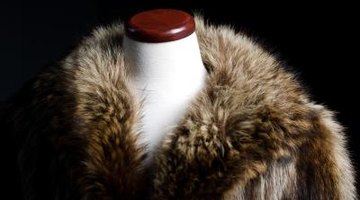How to Build a Temperature-Controlled Closet for Fur Coats & Special Clothing
Storing valuable garments in the proper conditions can extend their life and maintain their value. To help keep the temperature inside closets at a level that prevents humid conditions, a restoration specialist might recommend keeping the closet door open. However, when you are storing fur and special clothing, leaving the door open can make them more vulnerable to a pest infestation, such as moths.

Step 1
Remove all cedar components from the closet area. While cedar can help deter moths, it can cause the climate in a closet to become overly dry, which can ruin fur and leather coats. Items made from cedar can include the door, the rod on which you hang clothes and shelves. Replace these items with ones made from durable materials that are moisture- and mold-resistant.
Step 2
Install shelves. When storing valuable clothing that you cannot hang, it is best to keep it at least 2 feet off the ground in the event of water damage on the flooring. You can make your own shelves or buy ready-made shelves. The ideal shelves are made from mold- and water-damage resistant materials such as stainless steel or pressure-treated wood. A good location for shelving includes the top portion of the closet or at one end, if there is enough room.
Step 3
Dedicate enough room for your fur coats and other fur clothing. Your closet should be deep enough to hang furs on broad-shoulder plastic hangers and not touch the closet door when it is closed. The closet should also have enough space for you to hang your fur coats and accessories without them crushing or pressing into one another.
Step 4
Keep the closet away from heat. A closet near a radiator is not a good choice when storing fur and special clothing because the heat can produce mold or mildew if there is moisture in the environment. Turn off any vents connected to your home’s HVAC unit because heat can also cause fur clothing to form dry rot.
Step 5
Install a dedicated HVAC unit and thermostat for the closet so you can maintain a constant and cool temperature in the closet that is between 34 degrees Fahrenheit and 45 F.
Step 6
Place a humidifying/dehumidifying unit in the closet that is set to turn on when the humidity level is not ideal. The ideal humidity level for a fur closet is between 45 percent and 55 percent. Place the humidifying/dehumidifying unit in a location of the closet so it does not operate right next to the clothing. Place the unit on the side of closet opposite from the clothing, consider creating a dedicated shelf for the unit or install an HVAC unit that has humidity controls on it.
Tips
- Never fold fur coats and accessories to store them or allow them to lie flat.
- Never store fur or leather coats or clothes in garment bags.
- If you need to replace the door, replace it with a model that has a door sweep. If you are not replacing the door, add a draft stopper to the bottom of the door to help make the temperature-controlled closet operate more efficiently.
Writer Bio
Flora Richards-Gustafson has been writing professionally since 2003. She creates copy for websites, marketing materials and printed publications. Richards-Gustafson specializes in SEO and writing about small-business strategies, health and beauty, interior design, emergency preparedness and education. Richards-Gustafson received a Bachelor of Arts from George Fox University in 2003 and was recognized by Cambridge's "Who's Who" in 2009 as a leading woman entrepreneur.
Photo Credits
- Jupiterimages/Photos.com/Getty Images
More Articles



